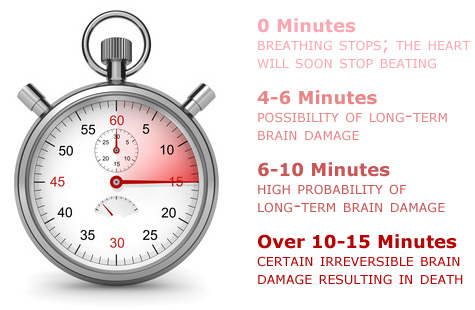How CPR Works
INTRODUCTION
Statistics indicate that sudden cardiac arrest (SCA) is rapidly becoming the leading cause of death. Once the heart ceases to function, a healthy human brain can survive without oxygen for up to 4 minutes without suffering permanent damage. But while typical Emergency Medical Service response time is only a few minutes, in remote or difficult to access areas EMS may take 15 minutes or more to arrive.
And it’s during those critical first minutes that CPR or Cardio (heart) Pulmonary (lung) Resuscitation (revive, revitalize) can provide oxygenated blood to the victim’s brain and the heart, dramatically increasing his chance of survival. And if properly instructed,  almost anyone can learn to perform CPR and to sustain the victim’s life in case of cardiac arrest. Invented in 1960, CPR is an effective procedure that forces oxygenated blood to the brain and the heart long enough to keep vital organs alive until EMS arrives. And to make learning CPR easier, an acronym was devised that makes remembering it as simple as C-A-B (Compressions-Airway-Breathing), with emphasis on the effort to continue to circulate the victim’s blood. It must be noted that CPR may not save every victim even when performed properly and timely, but statistics have consistently shown that if CPR is initiated within 4 minutes of cardiac arrest and is accompanied by defibrillation (AED) within 10 minutes, a person has a 40% chance or better, of survival.
almost anyone can learn to perform CPR and to sustain the victim’s life in case of cardiac arrest. Invented in 1960, CPR is an effective procedure that forces oxygenated blood to the brain and the heart long enough to keep vital organs alive until EMS arrives. And to make learning CPR easier, an acronym was devised that makes remembering it as simple as C-A-B (Compressions-Airway-Breathing), with emphasis on the effort to continue to circulate the victim’s blood. It must be noted that CPR may not save every victim even when performed properly and timely, but statistics have consistently shown that if CPR is initiated within 4 minutes of cardiac arrest and is accompanied by defibrillation (AED) within 10 minutes, a person has a 40% chance or better, of survival.
HOW CPR WORKS
Under normal circumstances and without ever thinking about it a healthy adult takes approximately 12-20 breaths every minute (children and infants take anywhere from 20 to 60 breaths per minute, depending on their age). The oxygen we inhale travels to the lungs where it’s picked up by the capillaries and carried to the heart to be pumped throughout the body. But when a person experiences cardiac arrest – whether due to heart disease related to such issues as long-term smoking, obesity, etc. in adults and the elderly, or accidental trauma and injury such as near-drowning, electrocution, etc. in children and infants – the heart is unable to perform its primary function: delivering oxygenated blood to our vital organs. This arrhythmic or erratic heart beat is called ventricular fibrillation and if it’s not corrected immediately, our cells and tissue begin to rapidly die. In essence, CPR acts as an artificial heart pump and external respirator during heart failure.
WHEN TO ACTIVATE EMERGENCY MEDICAL SERVICES
Dialing 9-1-1 (or your local emergency response number) may be the most important step you can take to save a life. If someone besides you is present, one of you should activate EMS immediately. However, if you’re alone with the victim, call for assistance (EMS) should be made prior to starting CPR on an adult, but after 2 minutes of administering CPR on a child or infant.
ASSESSING THE SCENE
Always remember to exercise solid common sense. When faced with an emergency situation we may sometimes act impulsively and place ourselves in harm’s way. Although time should not be wasted, remember to only approach the victim after determining that the scene is safe: always check for cars, fire, gas, downed electrical lines, and any other potential hazards before attempting to perform CPR.
CHAIN OF SURVIVAL
Beginning in 1991-92, the American Heart Association’s CPR and Emergency Cardiac Care (ECC) guidelines adapted the concept of Chain of Survival, a series of actions that improve survival rates in victims of cardiac arrest.

- The 5 “links” in this chain are:
-
- Prompt recognition of cardiac arrest and activation of EMS
-
- Immediate administration of CPR with emphasis on chest compressions
-
- Early defibrillation (AED)
-
- Rapid EMS intervention
-
- Rapid Advanced Life Support and care
LIABILITY
In most jurisdictions, the principle of Good Samaritan laws prevent negligence suits from being filed against any layperson (i.e. not medical professional) who makes a “good faith” effort to administer CPR or other forms of reasonable first aid assistance in an imminent emergency. However, it is worth noting that laws vary greatly from state to state and country to country.